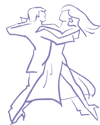 |
ROUND DANCING — CHOREOGRAPHED BALLROOMEDUCATIONAL ARTICLESMAJOR SECTIONS: Figures | Articles | Links | Alph. Index | Search | Home |
|
|
Move Your Body Firstby Harold & Meredith Sears Dance steps really should be thought of as two closely related movements. Of course, there is the movement of the foot. That's what a "step" is, isn't it? To dance forward is to move the free foot to the front, ahead of us, and then take weight on it, right? Not quite. The second part of a dance step is movement of the body, and it is important to smooth and comfortable dancing, to our ability to dance together, that we give as much or even more attention to the movement of the body as we do to the movement of the foot itself. We really need to get our body moving first — lower a little into the supporting knee, begin the forward movement of the body, or begin upper-body rotation if it is a turning figure — and then move the foot. If you step out from a standstill, it's a little like popping the clutch in a stick-shift car. Your partner won't expect it. If you begin with a little body movement first, you provide some warning or preparation—"we're off, honey." Now the actual step will flow.Consider the Corte. This is a one-step figure used in Tango and in Rumba. In Waltz and in Two Step, we call it a Dip. In closed position, the man steps to the side and back with his left foot, and of course, the woman follows, stepping side and forward right. We leave the trail feet extended, creating a graceful body line. Now, if the man reaches out with his foot and then plops his body weight onto that foot, the movement will be sudden, and the woman will not have had any warning — she will not have felt any lead — and she will feel jerked. Instead, he should lower into his right knee. This will tell his partner that he is commencing a figure. Second, he should begin to push off his supporting foot. This will add some direction to his lead, she will feel the movement through her upper-body frame, and she will comfortably move with him. Only then, should he move his left foot out, reaching for the actual Corte. The foot is much easier to move than the body. It is smaller and lighter. It will easily move ahead and be in its proper place by the time the body catches up. The body can then settle onto that support smoothly and comfortably. Here, the woman must be patient. She is being drawn into the step. But she must wait, lowered and balanced. Only when she feels the man take weight may she take her step. If she steps early, she will step on his brake pedal, and both will stop with a jerk. Or picture a Reverse Turn in Foxtrot. We begin in closed position facing line and center, and the first step is forward left for the man, beginning to turn left. There are at least three movements that begin this figure: a little initial lowering into the supporting leg, turning the body, and stepping with the foot. The step might be the most obvious of these three components, but if we take the step first and only later think about the rest of the body, the movement won't be smooth. Always think about the body first. Lower a little into the trail knee, begin to use a little right-shoulder lead (men) — you are, in essence, easing up on the clutch and smoothly getting your partnership moving. Push off with the trail feet. Now, you can take the step, with no surprises, jerks, shoves, or bumps. Again, ladies, don't take weight until your man does. You'll be smooth and together.
This article was published in the Washington Area Square Dancers Cooperative Association (WASCA) Calls 'n' Cues, 49-3:9, 11/2008; reprinted North Carolina Round Dance Association, 11/2012.
If you would like to read other articles on dance position, technique, styling, and specific dance rhythms, you may visit the article TOC. Past DRDC Educational Articles archived here. Go beyond this site. Find other references on our Sources and Links pages.
|
 |
|
|
Page last revised